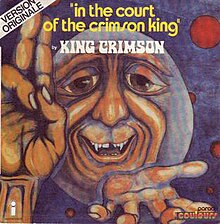The Court of the Crimson King
This article needs additional citations for verification. (January 2017) |
| "The Court of the Crimson King" | ||||
|---|---|---|---|---|
 | ||||
| Single by King Crimson | ||||
| from the album In the Court of the Crimson King | ||||
| A-side | "The Court of the Crimson King, Pt. 1" | |||
| B-side | "The Court of the Crimson King, Pt. 2" | |||
| Released | October 1969 (UK) December 1969 (US)[1] | |||
| Recorded | 21–23 July 1969 | |||
| Genre | Progressive rock[2] | |||
| Length |
| |||
| Label | ||||
| Composer(s) | Ian McDonald | |||
| Lyricist(s) | Peter Sinfield | |||
| Producer(s) | King Crimson | |||
| King Crimson singles chronology | ||||
| ||||
"The Court of the Crimson King", sometimes billed "In the Court of the Crimson King", is the titular fifth and final track from the British progressive rock band King Crimson's debut album, In the Court of the Crimson King. Released as a single, it reached No. 80 on the Billboard Hot 100 chart,[3] the only King Crimson single to chart on the Hot 100.
Background
The track is dominated by a distinctive, repeated four-bar riff performed on the mellotron. The main part of the song is split into four stanzas, divided by an instrumental section called "The Return of the Fire Witch". The song climaxes at seven minutes, but after a pause continues with a brief instrumental interlude called "The Dance of the Puppets", before ending with a reprise of the main theme. The music was composed by Ian McDonald, and the lyrics were written by Peter Sinfield.
Cash Box said "Unusual lyric imagery and instrumental impact with a 'Jude' hypnotism should set the side on a breakout path."[4] Record World called it "a heavy hard rock item with some classy jazz overtones."[5]
The track was used in the 2006 film Children of Men.[6]
Personnel
- Robert Fripp – guitars
- Greg Lake – bass guitar, lead vocals
- Ian McDonald – Mellotron, harpsichord, organ, flute, calliope, backing vocals
- Michael Giles – drums, percussion, backing vocals
- Peter Sinfield – lyrics
Charts
| Chart (1970) | Peak position |
|---|---|
| U.S. Billboard Hot 100[3] | 80 |
References
- ^ Strong, Martin Charles (1995). The Great Rock Discography. p. 460. ISBN 9780862415419.
- ^ Murphy, Sean (22 May 2011). "The 25 Best Progressive Rock Songs of All Time". PopMatters. Retrieved 31 July 2016.
- ^ a b "Hot 100 entry". Billboard. Retrieved November 14, 2017.
- ^ "CashBox Record Reviews" (PDF). Cash Box. January 10, 1970. p. 18. Retrieved 2023-04-29.
- ^ "Single Reviews" (PDF). Record World. January 10, 1970. p. 8. Retrieved 2023-04-29.
- ^ Crust, Kevin (7 January 2007). "Critic's Notebook; Sounds to match to the Children of Men vision". Los Angeles Times. p. E–24. Archived from the original on 2021-05-09.
